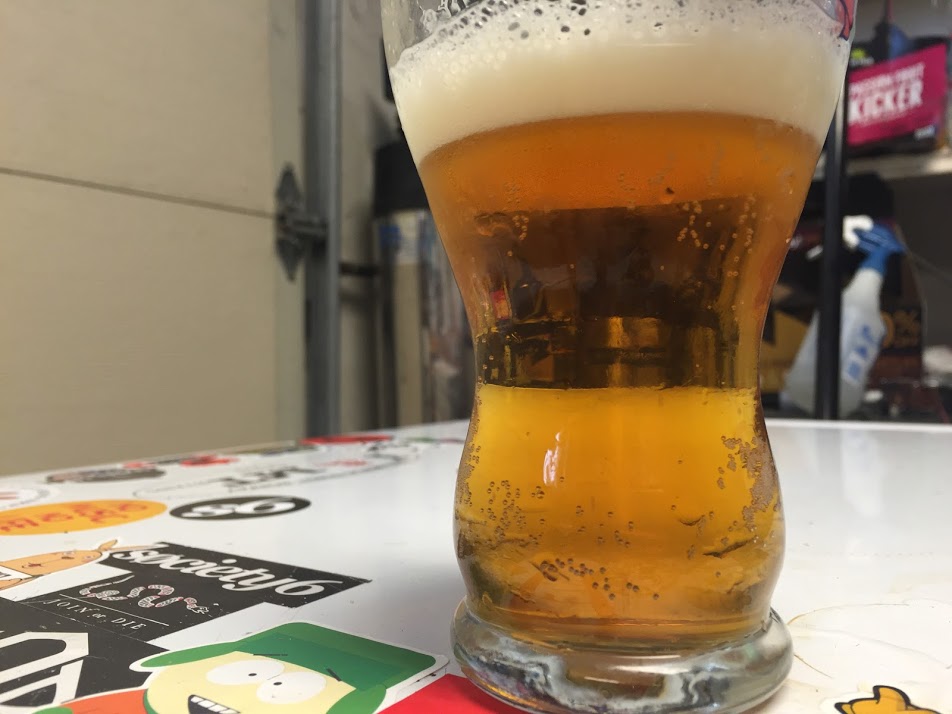I brewed this or very similar IPA recipe 5 times now.
Every time it came very clear, following the standard cold-crash -> gelatin -> keg (or bottle) strategy. (In fact ALL of my beers are generally very clear, with rare exception of wheat ales and of course dark beers like stouts).
But the last time this IPA came out hazy (and to my taste buds - more delicious) despite numerous clearing methods applied.
My last batch (15G one), I kept the grain bill basically the same but decided to make a few changes to hop schedule - I used hopshot for 90min addition to provide all the bitterness - in the past it was more complex schedule that involved Amarillo, Centennial, Magnum at 90 and 60min - which made little sense to me.
I also moved all late additions (like 30min additions) to flameout (to preserve most hop aroma) - hops that included Centennial, Simcoe and Amarillo. I split the 15G batch into three separate 5G batches, and used belgian yeast on one of the batches, and San Diego Superyeast on two others, as well as different dry hops (Hallertau Blanc and Centennial in one batch, Amarillo and Simcoe in another, Citra and Centennial in third).
All three batches were cold-crashed, gelatined (one of them was gelatined twice - once in carboy, once in keg, another one gelatined in carboy and then bio-fined in keg). They were cold-conditioned for 2 weeks now in kegs. Still hazy.
Because I used different dry-hopping procedures, I don't think dry hops are an issue. I suspect it's either hop-shot oils or late hop additions somehow strongly interacting with yeast to produce the haze?
So is it the hop-shot interactions, or perhaps moving hops to flameout that creates this East Coast IPA type haze that cannot be cleared?
Below is my basic recipe highlights and photos of the clear IPA (previous batch) and this current "East Coasty", hazy IPA.
Any ideas? By the way, I prefer the aroma/taste of this hazy IPA, but I do miss the clarity of the usual IPAs I brew.
US 2-row 87.5%
Cara-Pils 5%
Crystal 10L 5%
Caravienne 2.5%
Mash in at 148F
Hop schedule:
Hop-shot 90min (~80 IBU)
flame-out: 1.5 oz Cent., 1.5 oz Simcoe, 2 oz Amarillo (for 15G batch).


Every time it came very clear, following the standard cold-crash -> gelatin -> keg (or bottle) strategy. (In fact ALL of my beers are generally very clear, with rare exception of wheat ales and of course dark beers like stouts).
But the last time this IPA came out hazy (and to my taste buds - more delicious) despite numerous clearing methods applied.
My last batch (15G one), I kept the grain bill basically the same but decided to make a few changes to hop schedule - I used hopshot for 90min addition to provide all the bitterness - in the past it was more complex schedule that involved Amarillo, Centennial, Magnum at 90 and 60min - which made little sense to me.
I also moved all late additions (like 30min additions) to flameout (to preserve most hop aroma) - hops that included Centennial, Simcoe and Amarillo. I split the 15G batch into three separate 5G batches, and used belgian yeast on one of the batches, and San Diego Superyeast on two others, as well as different dry hops (Hallertau Blanc and Centennial in one batch, Amarillo and Simcoe in another, Citra and Centennial in third).
All three batches were cold-crashed, gelatined (one of them was gelatined twice - once in carboy, once in keg, another one gelatined in carboy and then bio-fined in keg). They were cold-conditioned for 2 weeks now in kegs. Still hazy.
Because I used different dry-hopping procedures, I don't think dry hops are an issue. I suspect it's either hop-shot oils or late hop additions somehow strongly interacting with yeast to produce the haze?
So is it the hop-shot interactions, or perhaps moving hops to flameout that creates this East Coast IPA type haze that cannot be cleared?
Below is my basic recipe highlights and photos of the clear IPA (previous batch) and this current "East Coasty", hazy IPA.
Any ideas? By the way, I prefer the aroma/taste of this hazy IPA, but I do miss the clarity of the usual IPAs I brew.
US 2-row 87.5%
Cara-Pils 5%
Crystal 10L 5%
Caravienne 2.5%
Mash in at 148F
Hop schedule:
Hop-shot 90min (~80 IBU)
flame-out: 1.5 oz Cent., 1.5 oz Simcoe, 2 oz Amarillo (for 15G batch).


















































![Craft A Brew - Safale S-04 Dry Yeast - Fermentis - English Ale Dry Yeast - For English and American Ales and Hard Apple Ciders - Ingredients for Home Brewing - Beer Making Supplies - [1 Pack]](https://m.media-amazon.com/images/I/41fVGNh6JfL._SL500_.jpg)










